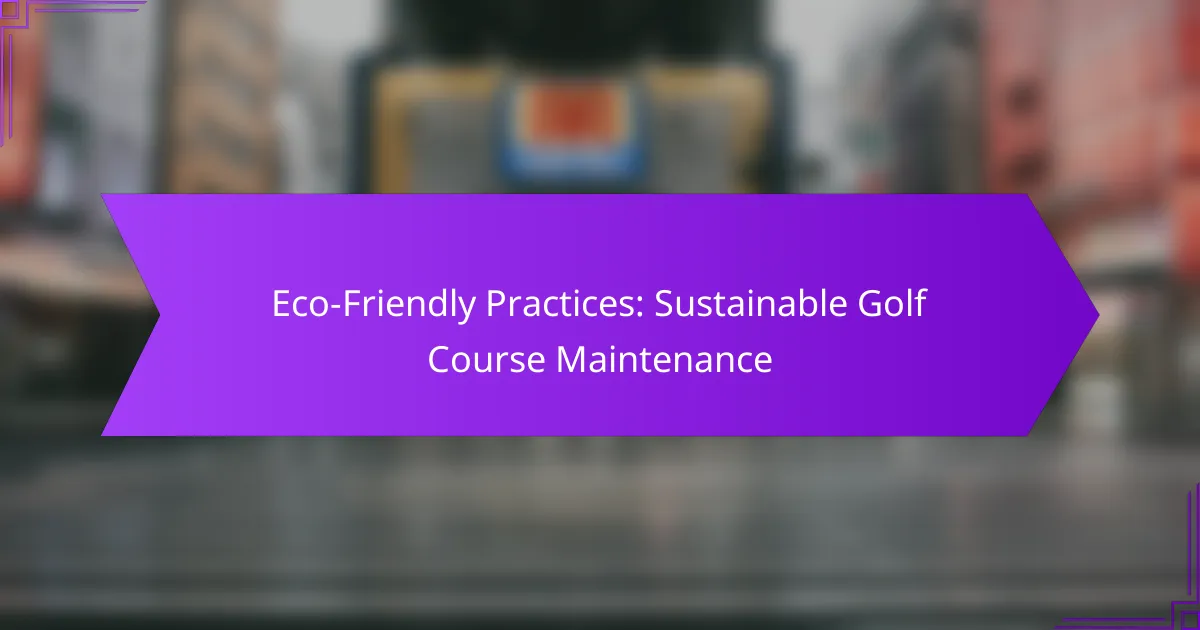Eco-friendly practices in golf course maintenance aim to reduce environmental impact while ensuring optimal playing conditions. By utilizing organic fertilizers, conserving water, and incorporating native plants, golf courses can promote sustainability and enhance biodiversity. These practices not only improve environmental health but also lead to cost savings and stronger community connections.

What are eco-friendly practices for golf course maintenance?
Eco-friendly practices for golf course maintenance focus on minimizing environmental impact while maintaining high-quality playing conditions. These practices include using organic fertilizers, conserving water, landscaping with native plants, implementing integrated pest management, and promoting recycling and waste reduction.
Organic fertilizers
Organic fertilizers enhance soil health and promote sustainable growth without the harmful effects of synthetic chemicals. Common options include compost, manure, and fish emulsion, which provide essential nutrients while improving soil structure.
When using organic fertilizers, consider applying them during the growing season to maximize their effectiveness. Aim for a balanced nutrient profile that supports turf health, typically with a focus on nitrogen, phosphorus, and potassium.
Water conservation techniques
Water conservation techniques are crucial for sustainable golf course maintenance, especially in regions prone to drought. Implementing practices such as drip irrigation, rainwater harvesting, and moisture sensors can significantly reduce water usage.
Additionally, scheduling irrigation during cooler hours can minimize evaporation. Regularly monitoring soil moisture levels helps ensure that water is applied only when necessary, promoting healthy turf while conserving resources.
Native plant landscaping
Native plant landscaping involves using indigenous flora that requires less water, fertilizer, and maintenance compared to non-native species. This approach not only supports local ecosystems but also enhances the aesthetic appeal of the golf course.
Consider incorporating native grasses, shrubs, and flowers in non-play areas to reduce maintenance costs and improve biodiversity. These plants are adapted to local conditions, making them more resilient to pests and diseases.
Integrated pest management
Integrated pest management (IPM) is a holistic approach to controlling pests while minimizing chemical use. IPM strategies include monitoring pest populations, using biological controls, and applying pesticides only when necessary.
Establishing thresholds for pest action can help determine when intervention is needed. This method not only protects the environment but also promotes healthier turf and reduces costs associated with excessive pesticide use.
Recycling and waste reduction
Recycling and waste reduction practices are essential for sustainable golf course maintenance. Implementing a recycling program for materials such as grass clippings, plastic, and metal can significantly reduce landfill waste.
Consider composting organic waste to create nutrient-rich soil amendments for landscaping. Additionally, educating staff and players about proper waste disposal can foster a culture of sustainability on the course.

How can golf courses implement sustainable maintenance?
Golf courses can implement sustainable maintenance by adopting practices that enhance environmental health while maintaining course quality. Key strategies include assessing soil health, using drought-resistant grass, and installing rainwater harvesting systems.
Conducting soil health assessments
Soil health assessments are crucial for understanding the nutrient levels and biological activity within the soil. Regular testing can identify deficiencies or imbalances, allowing for targeted amendments that improve soil quality and reduce chemical inputs.
Golf courses should consider conducting these assessments at least once a year. This practice not only promotes healthier turf but also minimizes the environmental impact by reducing the need for fertilizers and pesticides.
Utilizing drought-resistant grass varieties
Choosing drought-resistant grass varieties is an effective way to conserve water on golf courses. These grasses require less irrigation and are better adapted to withstand dry conditions, making them ideal for regions with limited water resources.
Common drought-resistant options include Bermuda grass and Zoysia grass. Implementing these varieties can significantly lower water usage, often by 30-50%, while maintaining a lush playing surface.
Implementing rainwater harvesting systems
Rainwater harvesting systems capture and store rainwater for irrigation, reducing reliance on municipal water supplies. These systems can be designed to collect runoff from roofs and paved areas, providing a sustainable water source for maintaining the golf course.
Courses can benefit from installing cisterns or tanks to store harvested rainwater. This practice not only lowers water costs but also helps manage stormwater runoff, contributing to local water conservation efforts.

What are the benefits of sustainable golf course maintenance?
Sustainable golf course maintenance offers numerous advantages, including cost efficiency, environmental health, and stronger community ties. By adopting eco-friendly practices, golf courses can reduce their operational costs while promoting biodiversity and enhancing their reputation within the community.
Cost savings on resources
Implementing sustainable practices can lead to significant cost savings on resources such as water, fertilizers, and pesticides. For instance, using drought-resistant grass varieties can reduce water consumption by up to 50%, which is particularly beneficial in regions facing water scarcity.
Additionally, organic fertilizers and integrated pest management can lower chemical costs and reduce the need for frequent applications. Golf courses can save money while maintaining healthy turf and minimizing environmental impact.
Enhanced biodiversity
Sustainable golf course maintenance promotes enhanced biodiversity by creating habitats for various plant and animal species. By incorporating native plants and minimizing chemical use, courses can support local ecosystems and improve soil health.
Practices such as creating buffer zones with native vegetation around water bodies can help protect aquatic life and improve water quality. This approach not only benefits the environment but also enriches the golfing experience by providing a more natural setting.
Improved community relations
Adopting sustainable maintenance practices can significantly improve community relations by demonstrating a commitment to environmental stewardship. Golf courses that engage in eco-friendly initiatives often gain support from local residents and environmental groups.
Hosting community events focused on sustainability, such as tree planting or educational workshops, can further strengthen these relationships. By involving the community in sustainability efforts, golf courses can foster goodwill and enhance their public image.

What certifications exist for sustainable golf courses?
Several certifications recognize sustainable practices in golf course management, focusing on environmental stewardship, resource conservation, and community engagement. These certifications help courses demonstrate their commitment to sustainability and can enhance their reputation among environmentally conscious players.
Audubon Cooperative Sanctuary Program
The Audubon Cooperative Sanctuary Program (ACSP) is designed to help golf courses protect the environment and enhance wildlife habitats. Participating courses must implement practices that promote biodiversity, such as creating native plant areas and managing water resources effectively.
To achieve certification, courses undergo a rigorous assessment that includes habitat management, water conservation, and pollution prevention. Successful completion of the program can lead to recognition as an environmentally friendly facility, appealing to eco-conscious golfers.
GEO Certified
The GEO Certified program focuses on sustainable golf course management through a comprehensive framework that addresses environmental, social, and economic aspects. This certification encourages courses to adopt practices that minimize their ecological footprint, such as reducing chemical use and improving energy efficiency.
Courses seeking GEO Certification must complete a self-assessment and demonstrate ongoing improvements in sustainability. This certification is recognized globally, making it a valuable asset for courses aiming to attract international visitors who prioritize green practices.
Green Globes Certification
Green Globes Certification is a flexible and comprehensive rating system that evaluates the sustainability of golf courses and other facilities. It emphasizes energy efficiency, water conservation, and sustainable site development, providing a clear pathway for courses to enhance their environmental performance.
To obtain Green Globes Certification, courses must complete an assessment that includes a review of their sustainability practices and an on-site evaluation. This certification not only helps courses improve their operations but also demonstrates their commitment to sustainability to players and the community.

How do local regulations impact sustainable golf course practices?
Local regulations significantly influence sustainable golf course practices by establishing guidelines for resource management and environmental protection. Compliance with these regulations ensures that golf courses can operate sustainably while minimizing their ecological footprint.
Water usage restrictions
Water usage restrictions are often implemented to conserve water resources, especially in regions prone to drought. Golf courses may be required to adhere to specific watering schedules or limits on irrigation, which can affect turf management and overall course maintenance.
To comply with these restrictions, golf courses can adopt practices such as using drought-resistant grass varieties, implementing rainwater harvesting systems, and utilizing smart irrigation technologies that optimize water use. Regular monitoring of soil moisture can also help in making informed irrigation decisions.
Pesticide application regulations
Pesticide application regulations dictate how and when chemicals can be used on golf courses to protect both human health and the environment. These regulations may include restrictions on certain pesticides or requirements for integrated pest management (IPM) practices.
Golf courses should focus on using environmentally friendly alternatives and adhering to application guidelines to minimize chemical runoff. Keeping detailed records of pesticide use and training staff on safe application methods are essential for compliance and sustainability.
Land use and zoning laws
Land use and zoning laws determine how land can be utilized for golf courses, influencing their design and operational practices. These regulations may require environmental assessments or limit development in sensitive areas, ensuring that golf courses do not disrupt local ecosystems.
Golf course operators should engage with local authorities to understand zoning requirements and seek opportunities for sustainable land management practices. Incorporating natural habitats and preserving native vegetation can enhance compliance while promoting biodiversity on the course.

What are the costs associated with eco-friendly golf course maintenance?
The costs of eco-friendly golf course maintenance can vary significantly based on the technologies and practices implemented. While initial investments may be higher, long-term savings on water, energy, and chemical inputs can offset these expenses.
Initial investment for sustainable technologies
Investing in sustainable technologies for golf course maintenance often requires a substantial upfront cost. This can include purchasing equipment such as electric mowers, solar-powered irrigation systems, and organic fertilizers. Depending on the scale of the course, initial investments can range from low tens of thousands to several hundred thousand dollars.
It’s essential to evaluate the return on investment (ROI) for these technologies. For instance, while solar irrigation systems may have a higher initial cost, they can significantly reduce water bills and maintenance costs over time. Consider conducting a cost-benefit analysis to determine the most effective technologies for your specific course.
Ongoing operational costs
Ongoing operational costs for eco-friendly maintenance practices can be lower than traditional methods. For example, using native plants and drought-resistant landscaping can reduce water usage and associated costs. Additionally, organic maintenance practices often require fewer chemical inputs, which can lower expenses.
However, it’s important to factor in the potential need for specialized training for staff to effectively implement and maintain these eco-friendly practices. This training can incur additional costs but is crucial for maximizing the benefits of sustainable maintenance.
Potential savings and benefits
While the initial costs of eco-friendly golf course maintenance can be high, the potential savings and benefits can be substantial. Many courses report reduced water and energy bills, leading to long-term financial savings. Furthermore, adopting sustainable practices can enhance the course’s reputation, attracting environmentally conscious players and potentially increasing membership and play rates.
Additionally, eco-friendly courses may qualify for various incentives or grants aimed at promoting sustainability. Research local and national programs that could help offset some of the costs associated with implementing these practices.



